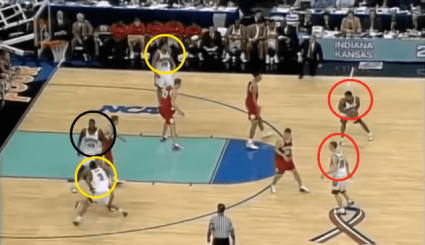You don’t see as many high-level teams run the flex offense as their primary plan much anymore, but you’ll still see plenty of teams run it occasionally. At the lower levels, though, it’s a very common tactic and a staple of high school hoops.
The flex offense still has a place in basketball.
This guide is meant to explain the flex offense in its most simple form. There are be variations to it, just like with any brand of offense, but this is the most standard version. If you are a coach, you might want to make adaptations to the original iteration that are unique or unique-ish to your team and style, but you must understand the core characteristics first before getting that far.
Flex Offense Setup
The flex offense utilizes a 4-out, 1-in setup with two players high on the perimeter, roughly even with the lane-lines extended or a bit wider, and three players low, two near the corners and one on either block. All of these positions are interchangeable as it’s a continuity offense, meaning all players constantly switch around positions when it’s run.

Down screens in screen-the-screener actions and the flex cut are the most common ways that players get open in the flex offense. The flex cut is so common that that’s where the offense’s name comes from, and as such, it is crucial to understand.
Flex Cut
In the above photo, white No. 3 is about to make a flex cut using white No. 45’s screen. In a flex cut, a player starts in the corner, then moves toward his/her teammate on the block, who is preparing a screen. This pick should lead the player into the lane, opening up an opportunity for a pass near the bucket.
This cut is an incredibly important part of this offense, and without it, a team will struggle to generate anything in the flex. It keeps the floor open, holds the defense honest and generates action near the hoop: all positive things.
The Flex Offense in Action
The motion of the offense is triggered when the pass between the two high players in completed. The player on the weak side corner utilizes a cross screen from the player on the block. Then, the player who set the cross screen will immediately roll high in a screen-the-screener action with a flex down screen from the perimeter player who made the initial pass. The pass back across to the player now at the top has to be made because it is the trigger for the offense to continue.
As this happens, a cross screen occurs on the weak side who received the first screen is now on the block. This goes on and on until a player finds a lane or sees an opening for a shot. The player using the cross screen can go over or under it depending on whatever they think is best for that situation.
Some aspects of this are not required. For example, when Gary Williams used to run the flex offense at Maryland, he didn’t like the screen-the-screener portion of the set, so he ignored it. But his team still ran the same offense with all the other hallmarks of the flex offense, and considering his program won a national championship in 2002, I think he might have had a point.
Pros
Not every team is properly equipped to run the flex offense, but plenty are. There are plenty of pros and cons to the system, but let’s start with the reasons why it can benefit your team.
Simple – one of the reasons why the flex offense is so popular at lower levels is because of how easy it is to learn. All the players are interchangeable, and no one has to learn anything any deeper than where to move when the trigger pass is made.
Quick Ball Movement – the flex offense encourages players to quickly get the ball out of their hands. There isn’t much room for dribbling in circles. You pass, you cut, you receive a pass, you pass, you cut. Not only can this make for more efficient offense, but it can also tire out the defense as following pinging passes and constant cuts is more draining than standing in front of your man as he/she dribbles in place.
Positionless Basketball – the modern game is moving further and further away from positions. Bigs are being asked to shoot and put it on the floor, and guards have to contribute more and more on the glass. The flex offense can help develop a team into a more well-rounded one as all players need the skills necessary to run it. This is truly a team offense, so everyone’s contributions are required for success.
Cons
Positionless Basketball – for the same reason why the flex offense can be great, it can also be the opposite if the team isn’t up for it. Some players really weren’t meant to play all five positions. That’s okay, but that’s not okay for a flex offense, where everyone has to be able to pass, handle the ball and shoot to at least a certain degree for success. If you have weak links who cannot reasonably play every position, then the flex might not be for you.
Monotony – the flex offense uses the same movements over and over again. This can lull the defense to sleep, but it can do the same to an offense. If the players aren’t fully bought in and willing to put full effort into every cut, every screen and every pass, then the set won’t work. But on top of that, it can be easy to get stuck in the cycle of running the set without looking to score. Players have to be aware of what’s going on around them at all times, especially if the ball is in their hands. The offense is meant to end at some point once an opening present itself, but if players are more focused on going through the motions than getting up a good shot, those opportunities will be missed.
Predictability – the flex offense isn’t a secret, and if it is, it won’t be for long when your team does the same thing over and over again. For teams that are solid defensively, it can be difficult to find space when the element of surprise is eliminated. There are wrinkles and other things that can be added to keep defenses guessing, but the issue can still remain. A common defensive tactic against the flex offense is to zone, which can be very effective. It’s important for a coach who runs the flex offense to have counters when presented with these situations.
Should You Run the Flex Offense?
There is no universal right answer here. There are many factors at play – how old and what level is your team, can your players play positionless basketball, are your players disciplined enough to run the offense well while not getting too wrapped up in the motions – and I don’t have the answer for you. However, if you’re coaching at a low level and need a basic set for your players to understand to generate some kind of motion in your offense, the flex might be worth looking in to, especially considering the numerous variations that can be added.







